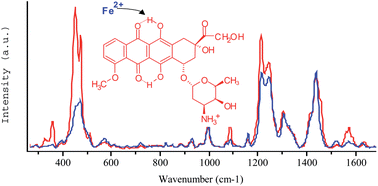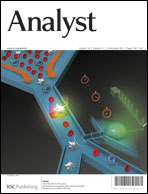SERS spectroscopic approach to study doxorubicin complexes with Fe2+ ions and drug release from SPION-based nanocarriers
Abstract
The aim of this work is to present a surface-enhanced Raman scattering (SERS) spectroscopic approach to study complexes of a frequently used antineoplastic agent, doxorubicin (DOX), with ferrous ions, at sub-micromolar concentrations in aqueous solution. The SERS bands of DOX were assigned according to critical analysis of literature. Prior to the complexation study, the spectral changes related to the drug orientation on the silver surface and to its protonation state were highlighted. The SERS spectra of DOX–Fe2+ complexes showed several features distinguishing them from the free drug, protonated or not on the phenolic part of its chromophore. The lowest detectable content of the DOX–iron complex in the presence of free DOX was estimated to be 5–10%. This property is particularly interesting from the analytical point of view, since it allows for study of drug–iron interactions upon the drug loading on and release from magnetic drug carriers based on superparamagnetic iron oxide nanoparticles (SPIONs), stabilized with citrate ions or coated with polyethylene glycol (PEG) polymer. Our SERS data indicate that the drug loaded on magnetic nanocarriers as DOX–iron chelate was mainly released in the free DOX form. These results demonstrate the strength of the SERS approach for the study of DOX–iron interactions in relation to delivery issues and drug action mechanisms.


 Please wait while we load your content...
Please wait while we load your content...